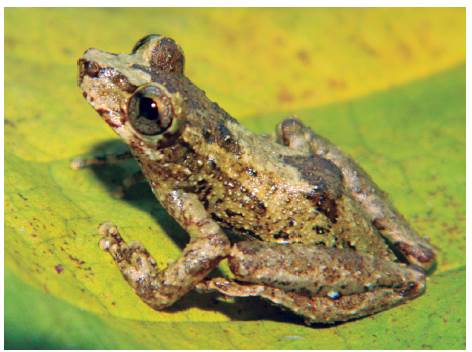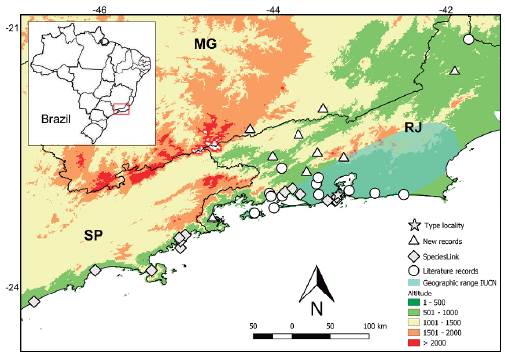Notas breves
New records of the Near Threatened species Ololygon trapicheiroi (Anura: Hylidae)
Nuevos registros de la especie casi amenazada Ololygon trapicheiroi (Anura: Hylidae)
Henrique Folly1
2
Larissa Arruda1
Elvis Almeida Pereira2
3
1 Programa de Pós-Graduação em Biologia Animal, Departamento de Biologia Animal, Universidade Federal de Viçosa, 36570-000, Viçosa, MG, Brazil. folly.henrique@gmail.com, larissaf.arruda@gmail.com
2 Mapinguari - Laboratório de Biogeografia e Sistemática de Anfíbios e Repteis, Universidade Federal de Mato Grosso do Sul, 79002-970, Campo Grande, MS, Brazil.
3 Programa de Pós-Graduação em Biologia animal, Departamento de Biologia Animal, Laboratório de Herpetologia, Universidade Federal Rural do Rio de Janeiro, 23890-000, Seropédica, RJ, Brazil.
ABSTRACT
Ololygon trapicheiroi is a small tree frog of the Ololygon catharinae group which inhabits mountainous areas in the Atlantic Rainforest region of Southeastern Brazil. On 30 April 2017, in the area rural of the Municipality of Passa Vinte, State of Minas Gerais, Brazil, we observed several specimens of Ololygon trapicheiroi. Here we report new records of Ololygon trapicheiroi throughout Minas Gerais, Rio de Janeiro and São Paulo states, Brazil and provide a distribution map of the species.
Keywords: Geographical distribution; Minas Gerais; Rio de Janeiro; São Paulo; Scinax
RESUMEN
Ololygon trapicheiroi es una pequeña rana arbórea del grupo Ololygon catharinae que habita en áreas montañosas en la región de la Selva Atlántica del sureste de Brasil. El 30 de abril de 2017, en el área rural del Municipio de Passa Vinte, estado de Minas Gerais, Brasil, observamos varios especímenes de Ololygon trapicheiroi. Aquí presentamos nuevos registros de Ololygon trapicheiroi en los estados de Minas Gerais, Río de Janeiro y São Paulo, Brasil y proporcionamos un mapa de distribución de la especie.
Palabras clave: Distribución geográfica; Minas Gerais; Rio de Janeiro; Scinax; São Paulo
The "Ololygon catharinae clade" currently comprises 46 species, and most of its diversity is distributed throughout the Atlantic Forest (Duellman et al. 2016). Ololygon trapicheiroi (Cardoso and Haddad, 1982) is a small tree frog from the O. catharinae group described for the Trapicheiro River, Tijuca, Rio de Janeiro municipality, Rio de Janeiro state. This species inhabits mountainous areas in the Atlantic Rainforest region of Southeastern Brazil (Carvalho-e-Silva and Carvalho-e-Silva 1994, Faivovich 2002, Rico et al. 2004, Van Sluys et al. 2006, de Luna-Dias et al. 2009). This species was listed on the IUCN Red List of Threatened Species as Near Threatened and the major threats that it faces are habitat loss due to deforestation arising from agricultural encroachment, infrastructure development, and fire (Rodrigues and Telles 2004).
On 30 April 2017, at 20 hs, in a rural area of the Municipality of Passa Vinte, State of Minas Gerais, we observed several specimens of O. trapicheiroi (Fig. 1). Males were found in reproductive activity, performing vocalization, and we also observed tadpoles of this species. We found the larvae in puddles formed in rocks and the individuals of O. trapicheiroi were collected in the vegetation on the banks of the Bananal River during a rainy night (22°8'58.04"South, 44°12'59.13"West; ca. 750 m a.s.l.). The collected specimens are housed in the Museu de Zoologia João Moojen (MZUFV 18464-18465, license ICMBio n° 54493-11). We confirmed the species diagnosis by morphological characters, following Lutz (1954).
Besides this record, based on analysis of specimens deposited in representative zoological collections, field work, and data available on SpeciesLink website (c2018) here we also report new records of O. trapicheiroi throughout Minas Gerais, Rio de Janeiro and São Paulo states, Brazil. We analyze records of this species in the following collections: Coleção de Girinos (UNESP), Coleção de Anfíbios do Museu de Zoologia (UNICAMP), NMNH Extant Specimen and Observation Records (Smithsonian Institution), Sistema de Informação do Programa Biota/Fapesp (SinBiota), Fundação de Amparo à Pesquisa do Estado de São Paulo, FAPESP, Coleção de Anfíbios (PUCRS), Museum of Comparative Zoology (Harvard University), Museu Nacional do Rio de Janeiro (MNRJ), Museu de Zoologia João Moo-jen (MZUFV). To avoid taxonomic mistakes, we discarded records with some taxonomic indetermination (e.g., O. aff. trapicheiroi or O. cf. trapicheiroi) from the SpeciesLink database (SpeciesLink c2018), since we did not examine these individuals.
Compiling data from museums, SpeciesLink, and field sampling, we present twenty-three new records of distribution for O. trapicheiroi and provide a current distribution map, including sites in the Minas Gerais, São Paulo and Rio de Janeiro states (Annex 1 in supplementary material).
The records of the municipalities of Passa Vinte and Belmiro Braga represent the first for the State of Minas Gerais and portray the most continental occurrence points of the species, expanding its distribution in approximately 134 km and 112 km, respectively, northwest of the type locality (Lutz 1954).
Through the SpeciesLink data, we added O. trapicheiroi records to new locations in the State of Rio de Janeiro and included unpublished records for the State of São Paulo, which is now the Southern limit of distribution of this species (Fig. 2).
Several species have their distribution associated with river basin valleys (e.g.,Feio and Caramaschi 1995, 2002, Feio et al. 1998, Santana et al. 2010, Araújo et al. 2013). Ololygon trapicheiroi was known only for lower areas of the coast of Rio de Janeiro State and Ilha Grande (de Luna-Dias et al. 2009, Silveira 2011). Typical species of coastal areas are favored by depressions and river valleys at low altitudes, and thus dispersed into inland areas, as observed in terrestrial segments of the Rio Doce (Feio et al. 1998, Feio et al. 1999), Jequitinhonha (Feio and Caramaschi 1995, 2002) and Paraíba do Sul Basin (Feio and Ferreira 2005, Santana et al. 2010, Pereira et al. 2016).
The new distribution records of O. trapicheiroi mentioned in this paper may be useful for a new assessment of their conservation status. It may be that this species is in a threat category of Least Concern rather than Near Threatened. Seems to be a well-established species that occurs in some protected areas and even in urban areas, where it reproduces in yards and gardens, in lotic or lentic collections of water or in artificial containers of water (Rodrigues and Telles 2004, de Luna-Dias et al. 2009).
ACKNOWLEDGMENTS
We thank the Instituto Chico Mendes de Conservação da Biodiversidade for collection permits and EAP acknowledges support scholarship from Conselho Nacional de Desenvolvimento Científico e Tecnológico (CNPq).
LITERATURE CITED
Araújo CO, Matsukuma CK, Almeida-Santos SM. 2013. Composição taxonómica e distribuição de anuros no Alto e Médio Paranapanema, estado de São Paulo. Biota Neotrop. 13(3):241-258. doi: http://dx.doi.org/10.1590/S1676-06032013000300027.
[ Links ]
Carvalho-e-Silva SP, de Carvalho-e-Silva AMPT. 1994. Descrição das larvas de Ololygon albicans e de Ololygon trapicheiroi com considerações sobre sua biologia (Amphibia, Anura, Hylidae). Rev. Brasileira de Biol. 54(1):55-62.
[ Links ]
de Luna-Dias C, de Carvalho-e-Silva SP, de Carvalho AMPT. 2009. Amphibia, Anura, Hylidae, Scinax trapicheiroi: Distribution extension. Check List 5(2):251-253. doi: http://dx.doi.org/10.15560/5.2.251.
[ Links ]
Duellman WE, Marion AB, Hedges SB. 2016. Phylogenetics, classification, and biogeography of the treefrogs (Amphibia: Anura: Arboranae). Zootaxa 4104(1):1-109. doi: http://dx.doi.org/10.11646/zootaxa.4104.1.1.
[ Links ]
Faivovich J. 2002. A cladistic analysis of Scinax (Anura: Hylidae). Cladistics 18(4):367-393. doi: https://dx.doi.org/10.1016/S0748-3007(02)00001-4.
[ Links ]
Feio RN, Caramaschi U. 1995. Aspectos zoogeográficos dos anfíbios do médio rio Jequitinhonha, nordeste de Minas Gerais, Brasil. Rev Ceres. 42(239):53-61.
[ Links ]
Feio RN, Braga UML, Wiederhecker H, Santos PS. 1998. Anfíbios do Parque Estadual do Rio Doce (Minas Gerais). Universidade Federal de Viçosa - Instituto Estadual de Florestas, Viçosa.
[ Links ]
Feio RN, Santos PS, Caramaschi U. 1999. New records of Amphibians from Parque Estadual do Rio Doce, State of Minas Gerais, Brazil. Herpetol. Rev. 30(1):56-57.
[ Links ]
Feio RN, Caramaschi U. 2002. Contribuição ao conhecimento da herpetofauna do nordeste do estado de Minas Gerais, Brasil. Phyllomedusa 1(2):105-111. doi: https://dx.doi.org/10.11606/issn.2316-9079.v112p105-111.
[ Links ]
Feio RN, Ferreira PL. 2005. Anfíbios de dois fragmentos de Mata Atlântica no município de Rio Novo, Minas Gerais. Rev. Bras. de Zoociências 7(1):121-128.
[ Links ]
Lutz B. 1954. Anfíbios Anuros do Distrito Federal. Mem. Inst. Oswaldo Cruz. 52(1):155-238. doi: http://dx.doi.org/10.1590/S0074-02761954000100009.
[ Links ]
Pereira EA, Neves MO, Hote PS, Santana DJ, Feio RN. 2016. Anurans of the Municipality of Barão de Monte Alto, Minas Gerais, Brazil. Check List 12(5):1-13. doi: http://dx.doi.org/10.15560/12.5.1977.
[ Links ]
Rico M, Rocha CFD, Borges VNT, Van Sluys M. 2004. Breeding ecology of Scinax trapicheiroi (Anura, Hylidae) at a creek in the Atlantic Rainforest of Ilha Grande, southeastern Brazil. Amphibia-Reptilia 25(3)277-286. doi: https://dx.doi.org/10.1163/1568538041975143.
[ Links ]
Rodrigues MT, Telles AM. 2004. Scinax trapicheiroi. The IUCN Red List of Threatened Species 2004:e.T56001A11403446. doi: http://dx.doi.org/10.2305/IUCN.UK.2004.RLTS.T56001A11403446.en.
[ Links ]
Santana DJ, São Pedro VA, Hote PS, Roberti HM, Sant'Anna AC, Figueiredo-de-Andrade CA, Feio RN. 2010. Anurans in the Region of the High Muriaé River, State of Minas Gerais, Brazil. Herpetol. Notes 3(1):1-10.
[ Links ]
Silveira AL. 2011. Geographic distribution: Scinax trapicheiroi. Herpetol. Rev. 42:109.
[ Links ]
SpeciesLink. c2018. SpeciesLink: Sistema de Informação Distribuído para Coleções Biológicas. [last accessed: 27 Dec 2018].
http://splink.org.br
[ Links ]
Van Sluys M, Rico M, Rocha CFD. 2006. Seasonal and hourly patterns of reproductive activity in Scinax trapicheiroi (Anura, Hylidae), Rio de Janeiro state, South-eastern Brazil. Herpetol. J. 16(1):15-20.
[ Links ]
















